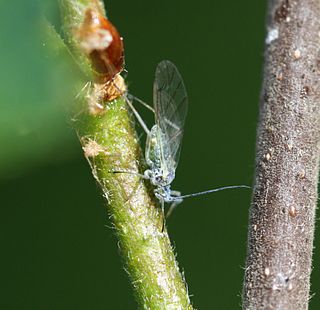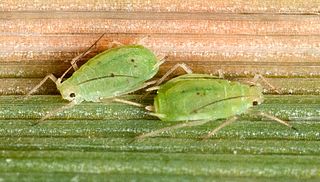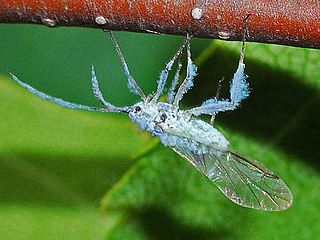Related Research Articles

Plum pox, also known as sharka, is the most devastating viral disease of stone fruit from the genus Prunus. The disease is caused by the plum pox virus (PPV), and the different strains may infect a variety of stone fruit species including peaches, apricots, plums, nectarine, almonds, and sweet and tart cherries. Wild and ornamental species of Prunus may also become infected by some strains of the virus.

Lepidosaphes ulmi also known as apple mussel scale or oystershell scale is a widely invasive scale insect that is a pest of trees and woody plants. The small insects attach themselves to bark and cause injury by sucking the tree's sap; this metabolic drain on the plant may kill a branch or the entire tree.

Rhaphigaster nebulosa, common name mottled shieldbug, is a species of stink bug in the family Pentatomidae.

Myzus persicae, known as the green peach aphid, greenfly, or the peach-potato aphid, is a small green aphid belonging to the order Hemiptera. It is the most significant aphid pest of peach trees, causing decreased growth, shrivelling of the leaves and the death of various tissues. It also acts as a vector for the transport of plant viruses such as cucumber mosaic virus (CMV), potato virus Y (PVY) and tobacco etch virus (TEV). Potato virus Y and potato leafroll virus can be passed to members of the nightshade/potato family (Solanaceae), and various mosaic viruses to many other food crops.

Macrosiphum rosae, the rose aphid, is a species of sap-sucking aphids in the subfamily Aphidinae. They have a world-wide distribution and infest rosebushes as the main host in spring and early summer, congregating on the tips of shoots and around new buds. Later in the summer, winged forms move to other rose bushes, or to a limited number of secondary hosts, before returning to rosebushes to lay eggs in the autumn.

Aphis gossypii is a tiny insect, an aphid ("greenfly") in the superfamily Aphidoidea in the order Hemiptera. It is a true bug and sucks sap from plants. It is a widely distributed pest of a variety of agricultural crops in the families Cucurbitaceae, Rutaceae and Malvaceae. Common names include cotton aphid, melon aphid and melon and cotton aphid.

The black bean aphid is a small black insect in the genus Aphis, with a broad, soft body, a member of the order Hemiptera. Other common names include blackfly, bean aphid, and beet leaf aphid. In the warmer months of the year, it is found in large numbers on the undersides of leaves and on the growing tips of host plants, including various agricultural crops and many wild and ornamental plants. Both winged and wingless forms exist, and at this time of year, they are all females. They suck sap from stems and leaves and cause distortion of the shoots, stunted plants, reduced yield, and spoiled crops. This aphid also acts as a vector for viruses that cause plant disease, and the honeydew it secretes may encourage the growth of sooty mould. It breeds profusely by live birth, but its numbers are kept in check, especially in the later part of the summer, by various predatory and parasitic insects. Ants feed on the honeydew it produces, and take active steps to remove predators. It is a widely distributed pest of agricultural crops and can be controlled by chemical or biological means. In the autumn, winged forms move to different host plants, where both males and females are produced. These mate and the females lay eggs which overwinter.

Aleurocanthus woglumi is a species of whitefly in the family Aleyrodidae. It is a pest of citrus crops, and is commonly known as the citrus blackfly because of its slate-blue colour. It originated in Asia, but has spread to other parts of the world. The parasitic wasps, Encarsia perplexa and Amitus hesperidum can help control the pest.

Macrosiphum euphorbiae, the potato aphid, is a sap-sucking pest insect in the family Aphididae. It infests potatoes and a number of other commercially important crops.

Euceraphis betulae, the birch aphid or silver birch aphid, is a species of aphid in the order Hemiptera. It is a tiny green insect with a soft body and wings. It is found living on the European silver birch tree where it feeds and multiplies on the buds and leaves by sucking sap.

Lipaphis erysimi is a species of aphid of the family Aphididae. Its common names include mustard aphid and turnip aphid. It is found in most temperate and tropical areas of the world and feeds only on cruciferous plants. The insects are almost exclusively female and are very prolific, with wingless females producing around one hundred young during a lifespan of a few weeks.
Cinara confinis, the black stem aphid, is a species of aphid in the genus Cinara, found feeding on the twigs of various species of fir (Abies) and on several other species of coniferous trees. This aphid has a Holarctic distribution and is known from Europe, Asia, North America and Argentina.

Aphis pomi, commonly known as the apple aphid, or the green apple aphid, is a true bug in the family Aphididae. It is found on young growth of apple trees and on other members of the rose family where it feeds by sucking sap. Reproduction is mainly by parthenogenesis, in which unmated females give birth to live young.

Brachycaudus cardui is a species of aphid, commonly known as the thistle aphid or the plum-thistle aphid. It infests trees in the genus Prunus in the spring and autumn, and mostly plants in the aster family in the summer.

Dysaphis crataegi, the hawthorn-carrot aphid, is an aphid in the superfamily Aphidoidea in the order Hemiptera. It is a true bug and sucks sap from plants.

The greenbug, or wheat aphid, is an aphid in the superfamily Aphidoidea in the order Hemiptera. It is a true bug and feeds on the leaves of Gramineae (grass) family members.

Eriosoma lanigerum, the woolly apple aphid, woolly aphid or American blight, is an aphid in the superfamily Aphidoidea in the order Hemiptera. It is a true bug and sucks sap from plants.

Metopolophium dirhodum, the rose-grain aphid or rose-grass aphid, is a species of sap-sucking insect in the family Aphididae found worldwide. Its primary host is rose, and its secondary host is a grass, including cereals such as wheat, barley, oats and rye. It is an important vector of the barley yellow dwarf virus (BYDV) which causes serious reductions in yields of affected crops.

Phyllaphis fagi, the woolly beech aphid, is a species of aphid in the family Aphididae.
References
- ↑ "ITIS standard report - Brachycaudus helichrysi (Kaltenbach, 1843)". Integrated Taxonomic Information System . Retrieved 26 July 2014.
- ↑ "Brachycaudus helichrysi (Kaltenbach, 1843)". Global Biodiversity Information Facility . Retrieved 24 July 2014.
- 1 2 3 "UC IPM - Leaf Curl Plum Aphid". University of California, Davis . Retrieved 24 July 2014.
- 1 2 3 Alford, David V. (17 July 2014). Pests of Fruit Crops: A Colour Handbook, Second Edition. CRC Press. pp. 74–75. ISBN 978-1-4822-5421-1.
- 1 2 Berim, M.N. "Pests: Brachycaudus helichrysi Kalt. - Leafcurl Plum Aphid". AgroAtlas. Retrieved 2015-02-18.
- 1 2 Van Emden, Helmut Fritz; Harrington, Richard (2007). Aphids as Crop Pests. CABI. p. 658. ISBN 978-0-85199-819-0.